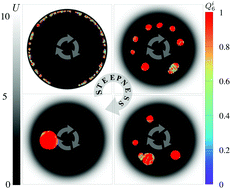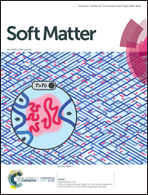Tuning the self-organization of confined active particles by the steepness of the trap†
Abstract
We consider the collective dynamics of self-propelling particles in two dimensions. They can align themselves according to the direction of propulsion of their neighbours, together with small rotational fluctuations. They also interact with each other via soft, isotropic, repulsive potentials. The particles are confined in a circular trap. The steepness of the trap is tuneable. The average packing fraction of the particles is low. When the trap is steep, particles flock along its boundary. They form a polar cluster that spreads over the boundary. The cluster is not spatially ordered. We show that when the steepness is decreased beyond a threshold value, the cluster becomes round and compact and eventually spatial order (hexagonal) emerges in addition to the pre-established polar order. We investigate the kinetics of such ordering. We find that while rotating around the centre of the trap along its circular boundary, the cluster needs to roll around its centre of mass to be spatially ordered. We have studied the stability of the order when the trap is suddenly switched off. We find that for the particles with velocity alignment interaction, the decay of the spatial order is much slower than the particles without the alignment interaction.



 Please wait while we load your content...
Please wait while we load your content...